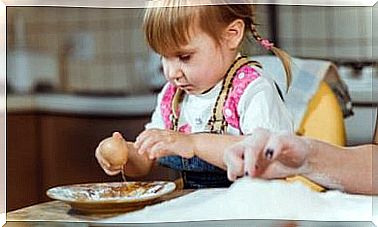Rivalry And Affection Between Siblings

Rivalry and affection between siblings is a family issue that can be of great concern to parents. There is no doubt that the relationship between siblings is extremely important. This is true regardless of whether siblings are in a good or bad relationship.
A warm and positive relationship between siblings not only provides an important link for learning development. It also represents one of the most special and irreplaceable relationships a person can have.
Rivalry and Affection During Childhood and Puberty
Sibling Rivalry in Childhood
The dynamics of family relationships undoubtedly and inevitably change with the arrival of a new sibling. These changes have a major effect on older siblings.
When a new baby arrives, older siblings can change their attachment behavior with their parents. In general, the attachment behavior increases and the older sibling develops a certain rivalry with the new family member.
Breastfeeding is without a doubt a tiring phase that affects a mother’s sleep routines, especially during the early months. Mothers are often exhausted at this stage, which affects their relationship with their older children.
Of course, they don’t have the same time, patience, or energy to devote to the older siblings as they did before. As a result, big siblings tend to increase their demands in an effort to regain lost ground.

With the arrival of a newborn baby, parental parenting of older siblings can also change. Their demands are getting higher, and so are the penalties. When they realize this, older siblings begin to experience jealousy.
They can express this through negative behavior towards parents or through a series of protests. For example: refusing to eat, not wanting to go to school, vomiting and sleeping problems. However, their behavior towards their new sibling seems to be contradictory. On the one hand there can be acceptance (hugs, kisses) and on the other hand rejection (aggression).
According to child psychologist Talia Velasco, this contradictory attitude is a reflection of two conflicting emotions. On the one hand, older siblings experience jealousy. At the same time, they also feel a strong affectionate bond with their little brother or sister.
Sibling Rivalry in Puberty
When puberty arrives, siblings can also come into conflict. This is true even for children who have had a loving and peaceful relationship as a child. One of the causes of this distance between siblings has to do with the search for more autonomy and intimacy within the family. At the same time, the dynamics between siblings can also change due to a difference in interests when the older sibling reaches puberty.
In many cases , the older sibling refuses to associate with or play with the younger one. However, the younger sibling will actually try to get the older sibling’s attention. This will eventually cause a lot of annoyance.
Affection between siblings
Jealousy and rivalry are common during childhood. Little by little, however, siblings come to a special and exclusive relationship. This relationship between siblings is very different from the relationship they have with their parents. In addition, the rivalry during puberty will gradually disappear as children form solid, loving relationships during childhood.
Siblings spend many hours a day and a lot of time together throughout their lives. The relationship between siblings is probably one of the most long lasting, when it comes to close relationships. Therefore, they will share many moments of happiness and pain.
Mary Ainsworth describes a series of observations regarding the bond between siblings:
- Older siblings provide care similar to that of a mother.
- Siblings help and comfort each other in the absence of their parents.
- Siblings serve as a base to explore each other.
- The anxiety associated with separation anxiety decreases in the presence of a sibling.
- When a loved one is lost, the grieving process is easier when a sibling is present.
- Going to school is easier when two siblings are together.
Do parents have influence when it comes to sibling rivalry and affection?
In their research on the relationship between siblings and their impact on child development, Nina Howe and Holly Rechia showed the importance of parents applying developmental techniques. These techniques should be appropriate for the age of their children.
According to their research , the techniques parents use to handle conflict between siblings teach them how to get along with others. Howe and Rechia distinguish between constructive and negative techniques in the various parental techniques. Positive approaches include actions to resolve conflict. Destructive approaches use methods such as violence and aggression.

Parents often and involuntarily contribute to sibling rivalry. For example, if they are constantly making comparisons between their children. This is the wrong message to children and teenagers.
They see that they have to live up to a certain standard in order to earn their parents’ affection. This, instead of being able to be themselves. At the same time, the child’s self-image is damaged. They develop feelings of resentment towards their sibling who seems to be up to the standard.
Rivalry and Affection: Conclusion
It is a known fact that the relationship between siblings is complex and every relationship is unique. There are siblings who have strong, positive bonds. Others may just have a broken relationship. It is the duty of parents to help raise their children with love and mutual support between siblings. By doing this, they help build one of the most authentic and amazing relationships around.









